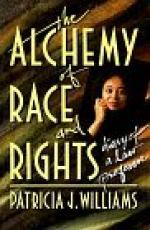
|
| Name: _________________________ | Period: ___________________ |
This test consists of 15 multiple choice questions and 5 short answer questions.
Multiple Choice Questions
1. What was Williams accused of being after sending her correspondence to the faculty?
(a) An opportunist.
(b) Didactic and condescending.
(c) Racist.
(d) Biased.
2. What was removed from the article Williams wrote after the first edit?
(a) The date it happened.
(b) The name of the store.
(c) Her expression of rage.
(d) Her race.
3. What does Williams say the liberal understand freedom as?
(a) The right to bear arms.
(b) Freedom of religion.
(c) Freedom of association.
(d) Freedom of speech.
4. What type of law did Williams teach?
(a) Commercial law.
(b) Criminal law.
(c) Injury law.
(d) Family law.
5. What does Williams argue capitalism did to everything?
(a) Spoiled it.
(b) Made is cheat.
(c) Exported it to China.
(d) Commodified it.
6. What does Williams want to show about legal language?
(a) It flattens complex issues.
(b) It protect the whites in power.
(c) It is necessary.
(d) It is reprehensible.
7. Where does Williams say a friend of hers was held at gunpoint?
(a) A police station.
(b) The White House.
(c) A white restaurant.
(d) The courthouse.
8. What does Williams say the "evidentiary rules" of legitimating turf war had whites believe?
(a) Children were always annoying.
(b) Women could multi-task.
(c) Jewish were rich.
(d) African-Americans were actively agressive.
9. What does Williams say her paper evaluations did to many students?
(a) It made them realize they were racists.
(b) It made them want to leave her class.
(c) It pleased them.
(d) It upset them.
10. What does Williams say was an important form of oppression?
(a) The image of the black criminal.
(b) Taxes.
(c) Black only neighborhoods.
(d) The police.
11. Who wrote the memo Williams received after talking with one of her students?
(a) Her mother.
(b) The associate dean.
(c) The dean.
(d) A student.
12. What does Williams argue capitalism turned the public into?
(a) Credit card holder.
(b) The private.
(c) Inactive people.
(d) Consumers.
13. What does Williams say the examples she gave in Part II, Chapter 4 illustrate?
(a) The neutrality of the law.
(b) Strong segregationist instinct among whites.
(c) Unlawful African-Americans.
(d) Racism among police officers.
14. What does Williams say required enforced equality and affirmative action?
(a) A race neutral society.
(b) Society.
(c) A lawful world.
(d) Democratic freedom.
15. What does Williams call the friend that suggested that her personal style of writing was too much for people?
(a) H.
(b) D.
(c) Q.
(d) U.
Short Answer Questions
1. What does Williams say was important for black students to do?
2. What did Williams' students often do when she exposed her ideas to them?
3. What does Williams say hypothetical cases were?
4. Who did Williams write an article for about her being prevented from entering the store?
5. What policy does Williams say she supported?
|
This section contains 449 words (approx. 2 pages at 300 words per page) |

|




